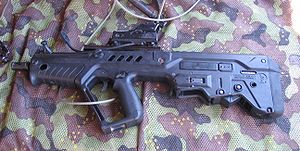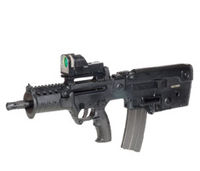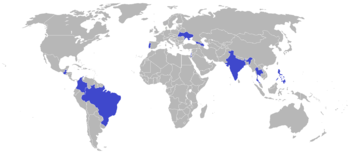IMI Tavor TAR-21
| TAR-21 | |
|---|---|
 СTAR-21 |
|
| Type | Assault rifle |
| Place of origin | |
| Service history | |
| In service | 2001–present |
| Used by | Israel, Others |
| Wars | Operation Defensive Shield, Operation Summer Rains, 2006 Lebanon War, 2008 South Ossetia War, Gaza War, Colombian armed conflict, 2008 Cambodian-Thai stand-off |
| Production history | |
| Designer | Israel Military Industries (IMI) |
| Designed | 1991–2001 |
| Manufacturer | Israel Weapon Industries (IWI) |
| Variants | See Variants |
| Specifications | |
| Weight | 3.27 kg (7.21 lb) (TAR-21)[1] 3.18 kg (7.0 lb) (CTAR-21)[1] 3.67 kg (8.1 lb) (STAR-21) 2.95 kg (6.5 lb) (MTAR-21)[1] 3.19 kg (7.0 lb) (TC-21) |
| Length | 720 mm (28.3 in) (TAR-21, STAR-21)[1] 640 mm (25.2 in) (CTAR-21)[1] 590 mm (23.2 in) (MTAR-21)[1] 670 mm (26.4 in) (TC-21) |
| Barrel length | 460 mm (18.1 in) (TAR-21, STAR-21)[1] 380 mm (15.0 in) (CTAR-21)[1] 330 mm (13.0 in) (MTAR-21)[1] 410 mm (16.1 in) (TC-21) |
|
|
|
| Cartridge | 5.56x45mm NATO[1] 9x19mm Para (Optional on MTAR-21)[1] |
| Action | Gas-operated, rotating bolt[1] |
| Rate of fire | 750-900 rounds/min[1] |
| Muzzle velocity | 910 m/s (2,986 ft/s) (TAR-21, STAR-21) 890 m/s (2,919.9 ft/s) (CTAR-21) 870 m/s (2,854.3 ft/s) (MTAR-21) 885 m/s (2,903.5 ft/s) (TC-21) |
| Effective range | 550m (estimated as the M16 rifle by the ammo and the barrel) |
| Feed system | Various STANAG magazines |
| Sights | ITL MARS with integrated laser and IR pointer, Trijicon ACOG (STAR-21), others available |
The TAR-21 (or simply Tavor) is an Israeli bullpup assault rifle chambered for 5.56x45mm NATO ammunition with a selective fire system, selecting between semi-automatic mode, burst mode, and full automatic fire mode. The name "TAR-21" stands for "Tavor Assault Rifle - 21st Century". It is the standard issued weapon of the Givati Brigade (since August 2006) and Golani Brigade (since August 2008), with the Nahal Brigade receiving it by 2010. The MTAR-21 (Micro Tavor) was recently selected as the future assault rifle of the Israeli Defense Forces, and within the next few years it will become the standard Israeli infantry weapon. It is named after Mount Tabor.
Contents |
Design
The TAR-21 uses a bullpup design, as seen with the French FAMAS, the British SA80, Austrian Steyr AUG, and the Chinese Norinco QBZ-95. Bullpup rifles are configured in a layout in which the bolt carrier group is placed behind the pistol grip; this shortens the overall length but does not sacrifice barrel length. The TAR-21 provides carbine length, but rifle muzzle velocity. The bullpup design is also used to minimize the silhouette of soldiers and to maximize effectiveness in turning corners in urban warfare.
The TAR-21 has ejection ports on both sides of the rifle so it can easily be reconfigured for right or left-handed shooters. However, this process requires partial disassembly, so it can not be quickly reconfigured while the rifle is in use.
The TAR-21 design was created by Zalmen Shebs, with the express purpose of creating a weapon more suited to urban combat than the M16/M4 carbine. It is based on advanced ergonomics and composite materials in order to produce a more comfortable and reliable rifle. The TAR-21 is waterproof and lightweight. The weapon has a built in laser and MARS red dot sight, one of the main advantages of having a built in system is that the weapon does not have to be zeroed after each use. The TAR-21 can also be mounted with an array of different scopes such as night vision systems and other electronic devices.
The TAR-21 accepts standard STANAG magazines. It can also be mounted with the M203 grenade launcher. Its ambidextrous fire mode selector above the pistol grip has a semi-automatic mode, burst mode, and a fully automatic mode.
Variants
The Tavor assault rifle comes in different variations:[2]
- TAR-21 - standard version intended for multirole infantry.
- GTAR-21 - standard version with notched barrel, to accept a M203 40 mm under-barrel grenade launcher.
- CTAR-21 - compact short barrel version intended for commandos and special forces.
- STAR-21 - designated marksman version with folding under-barrel bipod and Trijicon ACOG 4x magnification sight.
- MTAR-21 - see below.
- Zittara - Indian locally produced version of the MTAR-21 Micro Tavor modified to use the local 5.56x30mm MINSAS cartridge.
Micro Tavor

The Micro Tavor (MTAR-21), also designated X-95 and sometimes called Tavor-2, is a stand-alone extremely compact weapon specifically designed for special forces units, as well as military personnel who are normally not issued long assault rifles.
With the use of a relatively simple conversion kit, the MTAR-21 can be converted from a 5.56 mm assault rifle to a 9 mm submachine gun loaded with 20, 25, and 32-round magazines. A suppressor can also be added to the weapon, it is part of the 9 mm conversion kit. An integrated grenade launcher is currently being developed for the Micro Tavor. In November 2009, the Micro Tavor was selected as the future standard infantry weapon of the IDF, ahead of all other forms of Tavor.[3]
Semi-automatic
The semi-automatic Tavor Carbine (TC-21) has been conceived for civilian customers, and as a police patrol carbine for those countries, or law enforcement agencies, where full-automatic firearms are issued only to SWAT-like units. A semi-automatic Tavor carbine was first seen at the 2002 SHOT Show, when agreements were announced between IMI and the Barrett Firearms Company to manufacture the Tavor in both its military and civilian variants in the United States[4]. This was probably done in order to allow Israel to procure the Tavor using United States military aid money, since, according to American military assistance agreements, said funds must be spent to purchase US-manufactured equipments. The agreement between IMI and Barrett was never finalized, and the semi-automatic Tavor carbine as shown at the 2002 SHOT Show was never manufactured, although that specific design has recently resurfaced. The current Tavor Carbine, made in Israel by IWI, has been designed with slightly shortened barrel, otherwise being identical to the standard TAR-21 assault rifle. As of 2008, it is available for civilian customers to purchase in Canada.[5] The Canadian civilian version comes standard with the Mepro reflex sight and a slightly longer barrel to meet the Canadian requirement for non-restricted semi-automatic centerfire rifles to have a barrel length of at least 18.5 inches. There was a report by Charles Daly President Micheal Kassnar that plans were being made to import, or at least partially build, the Tavor in the United States, which was released through the Charles Daly forums.[6] However, since that time Charles Daly has gone out of business and the prospect of the sale of a semi-automatic version of the Tavor for the American civilian market is currently in question.
Use in Israel
After initial testing within Israel Defense Forces' infantry training units, the TAR-21 was distributed to members of the training company of the Tzabar Battalion from the Givati Brigade who were drafted in August 2001. They received their rifles in November 2001 during basic training. Initial results have been favorable - the TAR-21 was found to be significantly more accurate and reliable (as well as more comfortable) than the M4 carbine during extensive field testing - but the battle proven and widely issued M16 rifle and its variants will remain in service for some time to come; their unit purchase price is about one third that of the TAR-21. Originally there were some problems with fine sand getting into the Tavor's chamber, but reportedly, numerous adjustments were made and the problem has been corrected. Tavor CTAR-21 rifles saw combat service in Operation Cast Lead, used by Givati Brigade and Golani Brigade, and the soldiers reported the Tavor rifles functioned flawlessly.[7]
The rifle is in use by Givati Brigade and Golani Brigade, as well as by some special forces units of the Israel Defense Forces. The Nahal Brigade is currently in the process of switching to the Tavor, as part of a long term process in the IDF that seeks to equip all ground forces with the weapon.[8] Members of the unisex Caracal Battalion started receiving the rifle during the 2009 draft. It was the first time that female soldiers in the IDF were issued the Tavor. The switch was not expected to be too complicated, because the soldiers went through the basic and advanced training phases in the Givati Brigade training base, where they are already experienced with the use of the Tavor. According to Commander of the 512th Brigade, Colonel Amir Avivi, it was thought at first to introduce the Tavor rifle as soon as the advanced training phase of the March 2009 draft. However, it was eventually decided that the right thing to do will be to give a soldier one weapon from his conscription until his discharge. Therefore it was decided to begin the distribution from the August draft.[9]
In November 2009, it was announced that the Micro Tavor (MTAR-21), as opposed to the TAR-21, would become the standard infantry weapon of the IDF by 2011, with the addition of an integrated grenade-launcher.[3]
Export

 Azerbaijan: Azerbaijan purchased a number of TAR-21 for the special operations forces of the Azerbaijani Army in August 2008.[10]
Azerbaijan: Azerbaijan purchased a number of TAR-21 for the special operations forces of the Azerbaijani Army in August 2008.[10] Brazil: Taurus, the local firearms manufacturer, produces the Tavor rifles under license for the national market and offers this weapon to the Brazilian Army.[11]
Brazil: Taurus, the local firearms manufacturer, produces the Tavor rifles under license for the national market and offers this weapon to the Brazilian Army.[11] Colombia: The Colombian Army operates the TAR-21 for their special forces Agrupación de Fuerzas Especiales Antiterroristas Urbanas.[12]
Colombia: The Colombian Army operates the TAR-21 for their special forces Agrupación de Fuerzas Especiales Antiterroristas Urbanas.[12] Georgia: Since 2006, the Georgian Army has entered into a $65 million supply agreement for approximately 7,000 TAR-21 rifles (including different variants and grenade launchers). Uses all TAR-21 variants.[13]
Georgia: Since 2006, the Georgian Army has entered into a $65 million supply agreement for approximately 7,000 TAR-21 rifles (including different variants and grenade launchers). Uses all TAR-21 variants.[13] Guatemala: Guatemala's police force or PNC (Policia Nacional Civil) operates the TAR-21 for routine tasks, and some special operations.[14]
Guatemala: Guatemala's police force or PNC (Policia Nacional Civil) operates the TAR-21 for routine tasks, and some special operations.[14] India: In late 2002, India signed an Rs. 880 million (about $17.7 million) deal with Israel Military Industries for 3,070 Tavor assault rifles to be issued to India's special forces personnel,[15] where its ergonomics, reliability in heat and sand, and fast-point/fast-shoot design might give them an edge at close-quarters and employment from inside vehicles. By 2005, IMI had supplied 350–400 Tavors to India's northern Special Frontier Force (SFF). These were subsequently declared to be "operationally unsatisfactory". The required changes have since been made, and tests in Israel during 2006 went well, clearing the contracted consignment for delivery. The Tavor has now entered operational service – even as India gears up for a larger competition that could feature a 9 mm MTAR-21 version.[16] Known as the Zittara in Indian service,[17] the new Tavors have a modified single-piece stock and new sights, as well as Turkish-made MKEK T-40 40 mm under-barrel grenade launchers.[16]
India: In late 2002, India signed an Rs. 880 million (about $17.7 million) deal with Israel Military Industries for 3,070 Tavor assault rifles to be issued to India's special forces personnel,[15] where its ergonomics, reliability in heat and sand, and fast-point/fast-shoot design might give them an edge at close-quarters and employment from inside vehicles. By 2005, IMI had supplied 350–400 Tavors to India's northern Special Frontier Force (SFF). These were subsequently declared to be "operationally unsatisfactory". The required changes have since been made, and tests in Israel during 2006 went well, clearing the contracted consignment for delivery. The Tavor has now entered operational service – even as India gears up for a larger competition that could feature a 9 mm MTAR-21 version.[16] Known as the Zittara in Indian service,[17] the new Tavors have a modified single-piece stock and new sights, as well as Turkish-made MKEK T-40 40 mm under-barrel grenade launchers.[16]

 Philippines[18]
Philippines[18] Portugal: Small quantities of the TAR-21 are in use by field and intervention units of the Polícia Judiciária, like hostage negotiation teams and investigators who usually work alongside other dedicated law enforcement intervention units—the Special Operations Group (GOE) and the National Republican Guard's Special Operations Company (COE); these weapons were initially intended to equip a new unit under the command of the Polícia Judiciária resembling the GOE. The TAR-21 also participated in the competition for the new service rifle for the three branches of the Portuguese Armed Forces and the Police Special Operations Group (GOE)—a bid that also included the local production of the TAR-21 in Portugal. However, the TAR-21 was excluded from the shortlist. The competition has meanwhile been annulled, after the other contenders and both political and defense critics accused the competition of favoring the Heckler & Koch G36.[19][20]
Portugal: Small quantities of the TAR-21 are in use by field and intervention units of the Polícia Judiciária, like hostage negotiation teams and investigators who usually work alongside other dedicated law enforcement intervention units—the Special Operations Group (GOE) and the National Republican Guard's Special Operations Company (COE); these weapons were initially intended to equip a new unit under the command of the Polícia Judiciária resembling the GOE. The TAR-21 also participated in the competition for the new service rifle for the three branches of the Portuguese Armed Forces and the Police Special Operations Group (GOE)—a bid that also included the local production of the TAR-21 in Portugal. However, the TAR-21 was excluded from the shortlist. The competition has meanwhile been annulled, after the other contenders and both political and defense critics accused the competition of favoring the Heckler & Koch G36.[19][20] Thailand: The Royal Thai Army purchased 15,000 TAR-21 rifles. The second batch of 15,037 was ordered on September 9, 2008.[21] An additional 13,868 Tavor assault rifles for US$27.77 million (964.99 million baht) are to be purchased through three payments.[22]
Thailand: The Royal Thai Army purchased 15,000 TAR-21 rifles. The second batch of 15,037 was ordered on September 9, 2008.[21] An additional 13,868 Tavor assault rifles for US$27.77 million (964.99 million baht) are to be purchased through three payments.[22] Ukraine: Yuriy Lutsenko, head of Ministry of Internal Affairs of Ukraine, announced on October 1, 2008 that Israel Weapon Industries and the Ukrainian research and production company RPC Fort will jointly manufacture the Tavor TAR-21 assault rifle, that will enter service with the Ukrainian military and police special units.[23][24]
Ukraine: Yuriy Lutsenko, head of Ministry of Internal Affairs of Ukraine, announced on October 1, 2008 that Israel Weapon Industries and the Ukrainian research and production company RPC Fort will jointly manufacture the Tavor TAR-21 assault rifle, that will enter service with the Ukrainian military and police special units.[23][24]
See also
- SAR 21 Assault rifle
- Vektor CR-21 Assault rifle
- Modern Sub Machine Carbine
References
- ↑ 1.00 1.01 1.02 1.03 1.04 1.05 1.06 1.07 1.08 1.09 1.10 1.11 1.12 http://world.guns.ru/assault/as30-e.htm
- ↑ Israel Weapon Industries (I.W.I.): TAVOR TAR-21 5.56 mm
- ↑ 3.0 3.1 http://dover.idf.il/IDF/News_Channels/bamahana/09/043/01.htm
- ↑ http://www.gunblasTCom/SHOT_2002_2.htm SHOT Show 2002 Day 2 report
- ↑ http://www.canadaammo.com/product.php?productid=12&cat=0&page=1 IWI Tavor civilian semi-automatic carbine.
- ↑ http://www.charlesdalyforum.com/showthread.php?t=2169
- ↑ לאור תפקודו במבצע: אין עוד צורך בשיפור התבור, IDF Spokesperson, in Hebrew (In English the title reads: "Due to its performance during the operation: there are no further improvements required in the Tavor")
- ↑ IDF website - "Nahal Brigade Receives New Israeli Made Tavor"
- ↑ Female soldiers will be using the Tavor for the first time - IDF Spokesperson Website July 26, 2009
- ↑ Shahin Abbasov (2009-08-16). "Azerbaijan Mum about Israeli Spy Plane, Satellite Projects". EurasiaNet.org. http://www.eurasianet.org/departments/insightb/articles/eav081709a.shtml. Retrieved 2010-08-26.
- ↑ http://www.defesabrasil.com/laad2009/index.php?option=com_content&view=article&id=71:a-taurus-e-o-tavor&catid=39:noticias&Itemid=78
- ↑ http://unffmm.com/Galerias_AR/Galerias/v/GN/album_011/album/
- ↑ "Armament of the Georgian Army". Georgian Army. http://geoarmy.ge.ge/index.php?option=com_content&view=article&id=9&Itemid=9&lang=en. Retrieved 2010-08-24.
- ↑ Agentes todavía no saben utilizar fusiles comprados por el Gobierno.
- ↑ "One FIR, Govt blacklists 7 firms, hits artillery upgrade". The Indian Express. 2009-06-05. p. 2. http://www.indianexpress.com/news/one-fir-govt-blacklists-7-firms-hits-artillery-upgrade/472107/2. Retrieved 2009-06-09.
- ↑ 16.0 16.1 http://www.defenseindustrydaily.com/tavor21-rifle-headed-into-service-with-indian-special-forces-03080/
- ↑ http://ofbindia.gov.in/products/data/weapons/wsc/25.htm
- ↑ Ben-David, Alon (September 23, 2009). "In the Line of Fire: Infantry Weapons". Jane's Defence Weekly (ISSN: 02653818).
- ↑ Substituição da G-3: Governo recorreu para o Supremo, Diário Digital (Portuguese)
- ↑ Militares vão continuar a utilizar as velhas 'G3', Diário de Notícias (Portuguese)
- ↑ DefenseNews.com Thailand Plans $191.3M Arms Purchase
- ↑ Cabinet nod for Israeli rifles
- ↑ http://www.altair.com.pl/start-1862
- ↑ http://videonews.com.ua/videos/comments/655>
External links
- Israel Weapon Industries (I.W.I.): TAVOR TAR-21 5.56 mm
- Israel Weapon Industries (I.W.I.): Micro TAVOR MTAR-21 5.56 mm / 9 X 19 mm
- Tavor Israeli Weapons: The TAR-21 Tavor assault rifle
- Tavor-2 : Tavor-2 Advanced Assault rifle and Micro-Tavor
- Modern Firearms
- Arms World
- Israel's Infantry 2000 program
- Multi-Purpose munitions for the Tavor
- Tavor Program Update
- TAR-21 Indian made version (Zittara) manufactured by IOF
|
|||||||